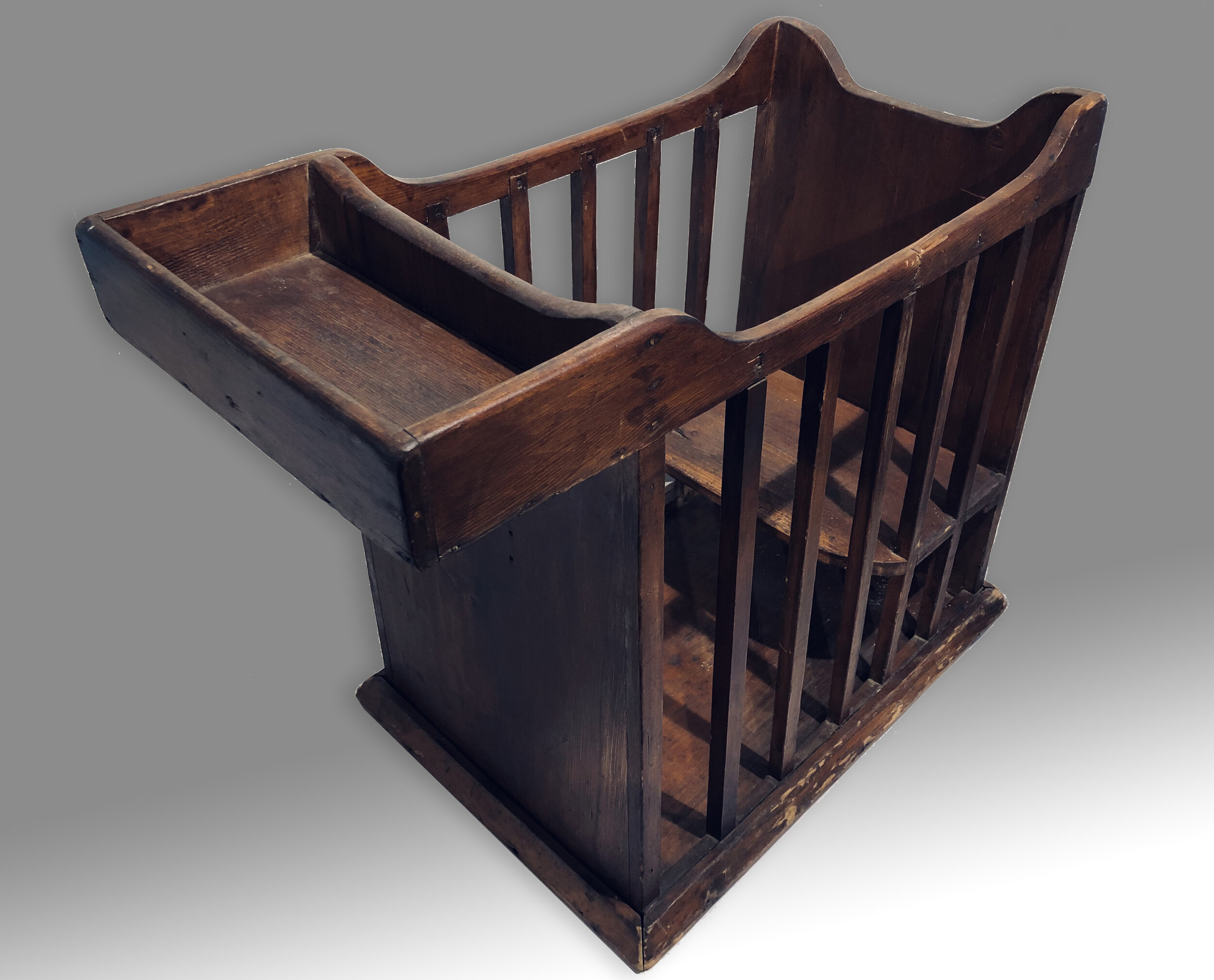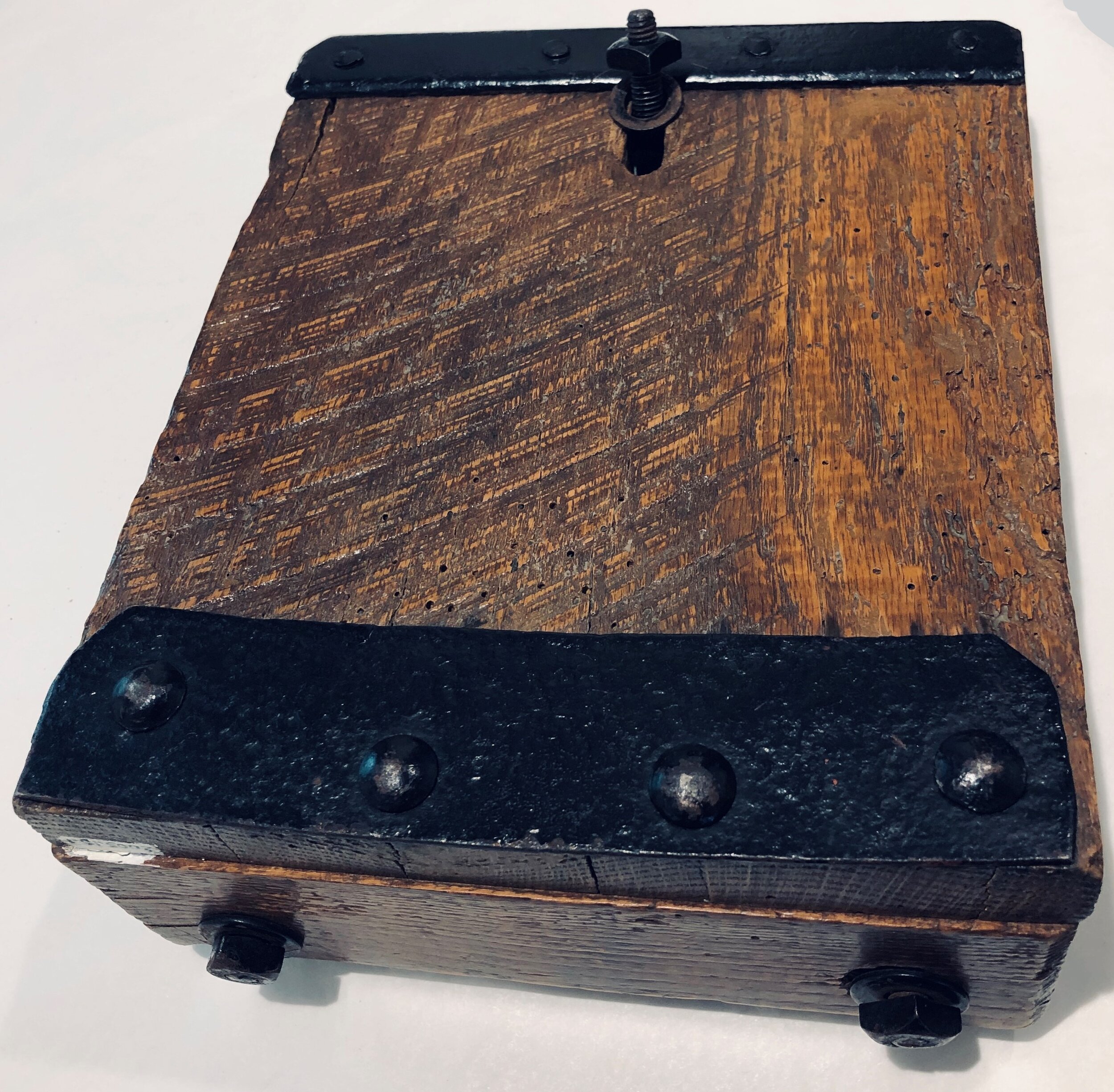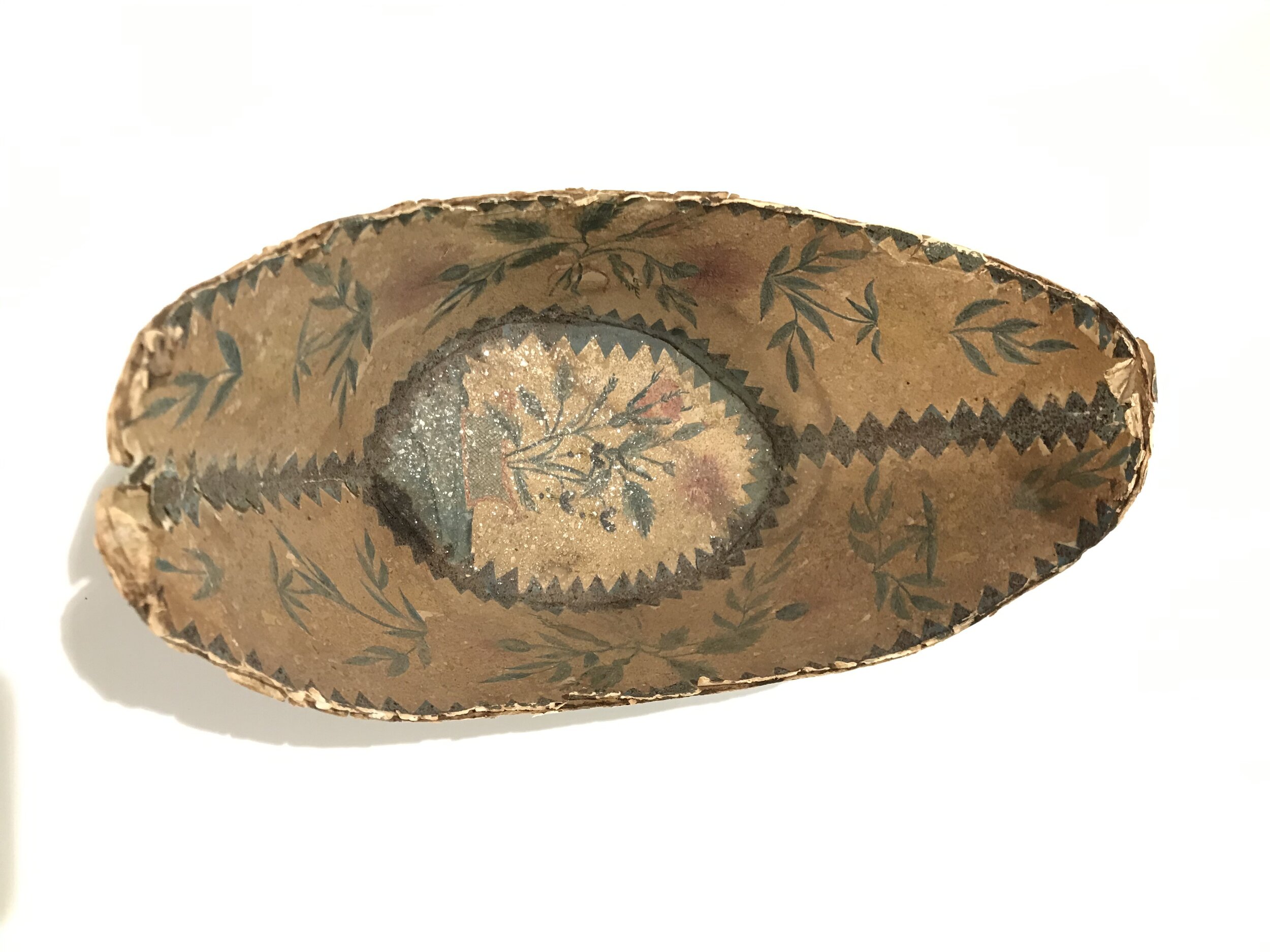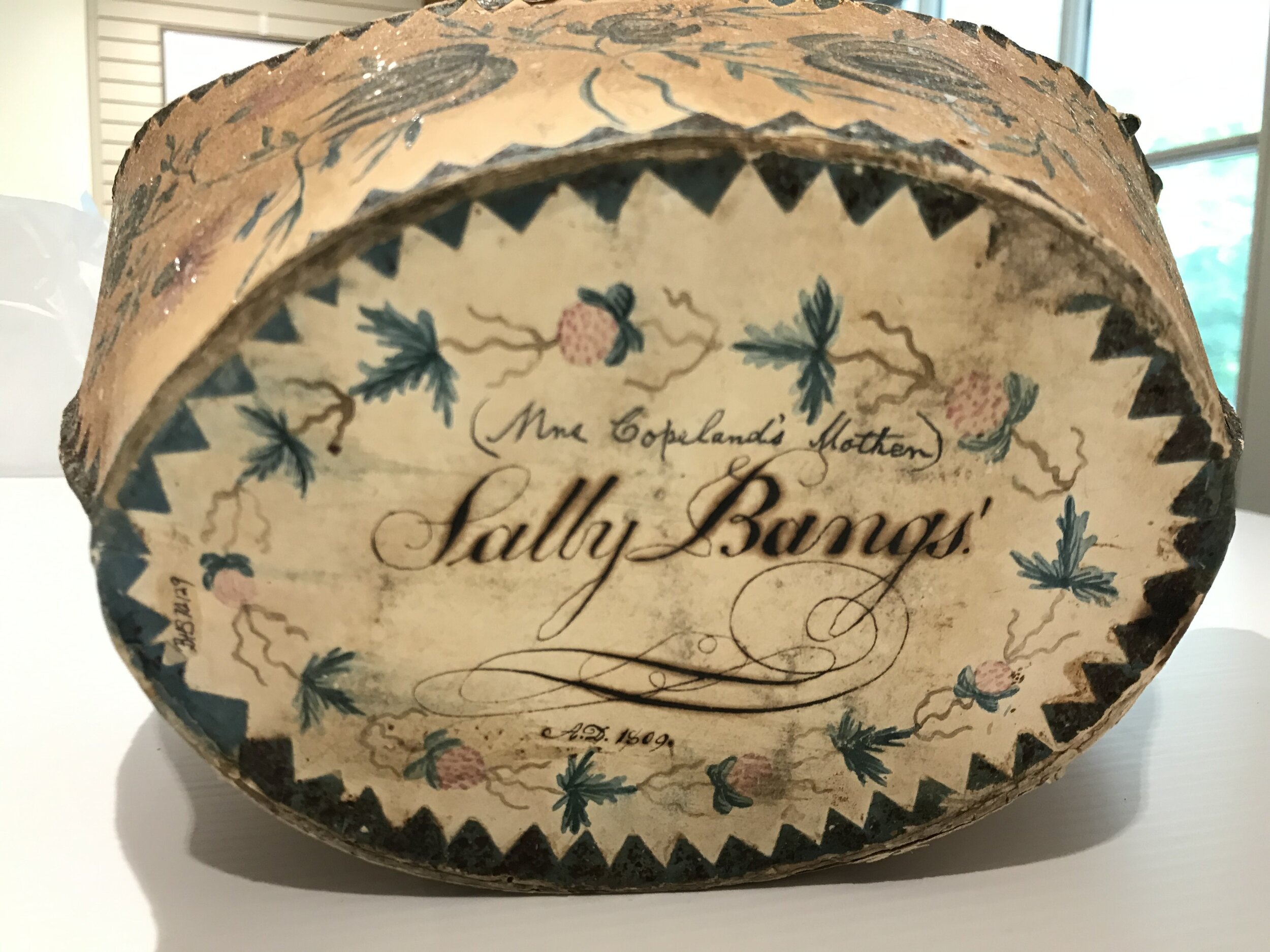The c. 1890s game of Jackstraws is similar to today’s game of pick-up-sticks. Wooden “straws” shaped like farming implements are spread onto a table and players try to remove them one-by-one without disturbing the other straws. In addition to the jackstraws there is a “helper” piece with a hooked edge to help move the sticks about. Each stick has a point value (penciled onto it), one stick having faces on it; perhaps the most coveted one, for it indicates a point value of “50.” At game’s end, the player with the highest point tally wins.
Read moreIn the Attic - Calash Bonnet
One of my favorite artifacts at the Cobb House is the charming, green, ladies bonnet. Great care was taken in the old days to properly frame a woman’s face with ruffles and silk. ~ BHS Docent, Cobb House Museum
Calash Bonnet, 1971.453
A “calash bonnet” was always formed of green silk; it was worn abroad, covering the head, but when in rooms it could fall back in folds like the springs of a calash or gig top; to keep it up over the head it was drawn up by a cord always held in the hand of the wearer. ~ Gift of Roland Allen, thought to belong to his mother, Emily Allen
In the Attic – Child's Winter Ensemble
A favorite museum item of mine is the child’s winter cape in the “Four Seasons of Fun” exhibit. It is amazing to think of the skill that went into sewing this piece – all so that a toddler could go out in the cold and snow! ~ BHS Docent, 1799 Cobb House Museum
Child’s Winter Ensemble from the 1800’s from the BHS permanent collection show a wool cape with handmade lace and tiny embroidered detail; a hat with earmuffs made of black velvet, gray wool trim and a button on top; and a muff and mittens for keeping hands warm. These came from the Captain Foster house on Main St., Brewster.
Photo courtesy of Diane and Stephen Jones
The Eddy sisters; Mary-Louise, Jean, and Ruth from the mid-1920’s, enjoying the Cape Cod wintertime in much the same way as their Brewster forebears must have in the previous century!
In the Attic – Ice Skates
Gift of the Family of Roland Allen
In the Brewster at Play gallery exhibit are two pairs of ice skates. It’s fun to imagine Brewster children of yesteryear enjoying ice skating on the many frozen ponds. Probably while parents were ice fishing or harvesting ice nearby. ~ BHS Docent, 1799 Cobb House Museum
By 1866, ice skating became so popular that it was considered the “national winter exercise.” People of all ages could enjoy ice skating for the cost of a pair of skates, which was as low as 35c.
Gift of Mrs. Olive Doyle
This pair are late 18th or early 20th century. These were found in the Harris - Black House (currently located at Windmill Village), probably made by a member of the family as they owned and operated a forge. They are made of iron, wood and leather.
In the Attic – Helen Keller in Brewster
In the spring of 1888, Mrs. Keller and Anne Sullivan brought Helen to the Perkins School, and that summer Sullivan brought the child with her to Cape Cod. They returned numerous times, staying at 1491 Main Street and 393 Lower Road.
Read moreIn the Attic – Antique Yoke
It has been my privilege and pleasure to occasionally show visitors around the Harris-Black house. My favorite part of the tour is helping people realize what life was like for the families that lived in the house in the late 18th to early 20th century. If there is one artifact that makes that point most strongly it would have to be the yoke. The idea of having to carry water for everything that water is needed for makes a powerful impression. ~ BHS Docent, 1795 Harris-Black House Museum
1795 Harris-Black House
John Harris, a “seafaring man",” and wife Sarah paid five pounds eight shillings for three acres of woodland and built this sixteen foot square house. They had six children. To our knowledge, of the many small early houses believed to have existed throughout the Cape, only one has survived. First used as a homestead dwelling, as it passed down through generations it was later used as a cranberry storeroom and a small forge. The house was eventually moved to its present location and restored by John MacKenzie. The BHS maintains it as part of the Windmill Village.
In the Attic – 1880s Brewster Map
One of my favorite pieces is the old map of Brewster on the second floor. As a docent, I found that people were fascinated to see exactly where they were in relation to the entire town, and the Cobb name on the map. I did too!! ~ BHS Docent, Cobb House Museum
Map of Brewster, MA c. 1860s shows original property owners names of the period, rather than addresses. The railroad came through in 1865 connecting Harwich and Brewster. The tracks intersected with Main Street just east of Crosby Lane. It is part of the Brewster Historical Society research room at the Cobb House Museum. Research queries are handled by volunteers in the order they are received. Supervised research will be by appointment only.
In the Attic - Child Tender
My favorite is the toddler “cage” by the fireplace in the entry room. It is unique and probably hand built. Its use is indescribable. ~ BHS Docent, Cobb House Museum
This early child’s highchair/playpen used through many generations, belonged to Ida Winslow Foster, who was born at High Brewster. ~ Gift of the Cleverley-McConchie Family
18th and 19th century homes contained many hazards for young, mobile children. Open fires posed a particular danger, as did the scalding water usually heating over it. Baby tenders like this one kept little ones temporarily out of harm's way while older household members performed their day-to-day tasks. Most households did not use such devices. They often relied instead upon older children to watch over younger siblings. Young children were often left entirely to their own devices, sometimes with tragic results. americancenturies.mass.edu
In the Attic - The Undaunted
My favorite object in the Elijah Cobb house is the painting of the “The Undaunted”, an oil on canvas, of a clipper ship under full sail. The nineteenth century clipper ship was captained by Brewster resident William Freeman who built the Greek Revival home on Breakwater Road.
~ BHS Docent
Undaunted executed by Egide Linning (1821-1860) in 1857. Gifted to BHS by Capt. Freeman’s youngest daughter, Phebe Freeman Focht.
Undaunted
Kingfisher
CAPTAIN WILLIAM FREEMAN -- located his home convenient to the packet landing. Capt. Freeman commanded the famed clipper ship Kingfisher, the Maine, the Undaunted, the Monsoon, the Mogul, the Ocean King, and Jabez Howes. Unlike most of his other Brewster compatriots, he also captained three steamers: Zenobia, Palmyra, and Edward Everett. Ironically, The Maine was lost on a bar in the Kennebec River.
In the Attic - Sea Captain's Medicine Chest
One of my favorite artifacts in the Cobb House is the sea captain’s personal medicine chest. I admire the design and function, but most of all, the fine workmanship of the impressive mahogany chest. A bonus is the chest also contains 3 original items: epsom salts, hartshorn, and turkey rhubarb, named for the route taken from China before its journey to America. Another remarkable item on exhibit at the Cobb House Museum!
~ BHS Docent
This elegant mahogany chest belonged to Capt. William Freeman of Brewster (1820 – 1911). It may have been for personal use only; however, early ship’s captains administered medical advice. His medicine chest included a book with symptoms that refer to numbered bottles and the strength of dosages. The donor of this chest was the last surviving child of Capt. Freeman. She was born when he was seventy and passed away in 1976.
~ Bequest of Phebe Freeman Focht
William Freeman commanded ships Maine, Undaunted, Kingfisher, Monsoon, Mogul, Ocean King, and Jabez Howes. On the 1874 passage of the Mogul from Liverpool to San Francisco the cargo of coal took fire by spontaneous combustion on July 26. After two weeks they abandoned ship and took to three life boats with 27 men. After 12 days they all reached the Marquesas 2100 miles away. Rescued by a small sloop they were transported to Nukahioa and then by schooner to Tahiti. After four months they were returned to San Francisco.
In the Attic - Bog Shoe
Horses were once used to work in cranberry bogs and salt marshes. To prevent the horse sinking and getting stuck in the soft soil, bog shoes of cut wood were strapped onto the horse’s hooves. Bog or marsh shoes worked in the same manner a snow shoe works. The bog shoe is big and has holes and a slot made to receive protrusions on the horse’s shoes which were bolted to secure.
Fred Young, a local weir fisherman, might have used these shoes on his horse while collecting his catch from his weirs off Point of Rocks beach in Brewster.
Donated by Henry N. Foster
In the Attic - 1805 Container
Tole style folk art, sanded yellow papier-mâché boat-shaped container. Hand painted inside and out with vines and red flowers. Signed “Sally Bangs 1809” on the bottom. Donated by her descendant Cordelia Keith.































